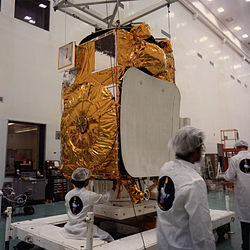- Master Control Facility (ISRO)
-
The Master Control Facility (MCF)(Hindi:मुख्य नियंत्रण सुविधा) is a facility set up by the Indian Space Research Organisation (ISRO) in the city of Hassan in the Indian state of Karnataka.[1] Established in 1982, this facility is responsible for monitoring and controlling the satellites launched by ISRO.[2] This was the only Master Control Facility of ISRO till another one was established in Bhopal in 2005.[3]
Contents
Establishment
When ISRO wanted to establish a control facility, it inspected various sites that were offered to it within India. ISRO chose Hassan as the location (Location on Google Maps) because it was free of noise and encountered less terrestrial transmission than other proposed sites.[1] Low interference was a must since the facility should be able to pick up even very weak signals from the satellite. The land to setup this facility was spread across 17.2 hectares and offered by the Government of Karnataka.
Internal divisions
The MCF has three internal divisions; the Spacecraft Control Centre, Mission Control Centre and the Earth station.[1]
Spacecraft Control Centre
This centre is responsible for controlling satellites and various commands are sent from this centre to the satellite to undertake the desired operations.
Mission Control Centre
This centre plays a major role mainly during the launch of the satellite and its initial period in space. This is the place where the Mission Director and the different designers of the various modules in the satellite keep a watch on the functioning of the satellite. They do this by studying the various telemetry signals that the satellites send, related to the health of its various modules. In case of any deviation from the prescribed limits of the parameters, an automatic alarm is sounded and the respective designers discuss with the Mission Director and send corrections to the satellite from this centre.[1]
Earth station
MCF has an integrated facility consisting of seven earth stations.[4] The earth stations are assisted by an antenna array which provide the communication link between the satellite and the MCF. The MCF has 3 full-motion and about a dozen limited-motion antennas. The full-motion antennas can be turned around 360° and can be tilted from zero° to 90° in elevation. They send commands to the satellite, receive signals from it, thereby also helping to check that the satellite is in orbit. The full motion antennas are mostly used during the satellite launch and once the satellite is in its prescribed orbit, the limited motion antennas take over the communication link with the satellite.[1]
Satellites
Currently MCF, Hassan controls the following 7 satellites: INSAT-2E, INSAT-3C, INSAT-3A, INSAT-3E, INSAT-4A, KALPANA-1 and GSAT-2.[4]. In October 1997, the MCF lost contact with the INSAT-2D satellite which was a serious blow to ISRO.[5] This glitch also affected the National Stock Exchange at Mumbai which had to suspend trading on October 3, 1997 till the VSAT terminals which it depended on were transferred to INSAT-2A.[5] Previously, this facility also controlled ISRO's earlier generation of satellites, like the INSAT-1B.[6]
Scientists
C G Patil is the current Director of MCF. It has been identified that before the launch of any satellite, a group of scientists from MCF visit the Sri Manjunathaswamy temple at Dharmasthala to pray for the successful launch of the satellite. They bring a miniature model of the satellite with them, which is also prayed along with the God and the model is later donated to the temple.[7]
INSAT Master Control Facility
The INSAT Master Control Facility is one of the centers of Indian Space Research Organisation, which is responsible for post-launch operations on INSAT satellites including orbit manoeuvres, station keeping and on-orbit operations. INSAT MCF of ISRO are located at two locations, Hassan in the South Indian state of Karnataka and at Bhopal in Madhya Pradesh. At present, the centers support on-orbit operations on INSAT-3A, INSAT-3B, INSAT-3C, INSAT-3E, Kalpana-1, GSAT-3 and INSAT-4B satellites.
Notes
- ^ a b c d e T. S. Subramanian. "Support systems on the ground". Online Edition of The Frontline, Volume 16 - Issue 8, Apr. 10 - 23, 1999. http://www.hinduonnet.com/fline/fl1608/16080160.htm. Retrieved 2007-10-17.
- ^ "Orbit Chasers". Online webpage of The Indian Express, dated 2007-09-09. http://www.indianexpress.com/sunday/story/215171.html. Retrieved 2007-10-17.
- ^ "Second ISRO master control facility inaugurated in Bhopal". Online Edition of The Hindu, dated 2005-04-12 (Chennai, India). 2005-04-12. http://www.hindu.com/2005/04/12/stories/2005041207761100.htm. Retrieved 2007-10-17.
- ^ a b "Communication and Meteorological Satellite System". Online webpage of ISRO. Archived from the original on 2007-10-14. http://web.archive.org/web/20071014010900/http://www.isro.org/rep2007/Communication&Matereological.htm. Retrieved 2007-10-17.
- ^ a b T.S. Subramanian. "A setback to ISRO". Online Edition of The Frontline, Vol. 14 :: No. 21 :: Oct. 18 - 31, 1997. http://www.hinduonnet.com/fline/fl1421/14210520.htm. Retrieved 2007-10-17.
- ^ "STS-8 Press Kit". Online webpage of NASA. http://www.jsc.nasa.gov/history/shuttle_pk/pk/Flight_008_STS-008_Press_Kit.pdf. Retrieved 2007-10-17.
- ^ "A prayer before the launch of every ISRO satellite". Online Edition of The Hindu, dated 2005-12-24 (Chennai, India). 2005-12-24. http://www.hindu.com/2005/12/24/stories/2005122400250200.htm. Retrieved 2007-10-17.
Indian Space Research Organisation (ISRO) Robotic missions PastCurrentFutureSatellites Earth observationBhaskara Satellite series · IRSCommunication & WeatherNavigationLaunch vehicle
fleetExpendable launch systemReusable launch systemAVATAR RLV (planned)Human spaceflight
programmeTechnology demonstrationCrew vehicleLaunch vehicleAstronomy and
planetary sciencesInstitutionsNational Atmospheric Research Laboratory · Indian Institute of Astrophysics
· Indian Institute of Space Science and TechnologyObservatoriesPeople AstronautsScientistsOther Bhuvan · List of Indian satellitesCategories:- Indian Space Research Organisation facilities
Wikimedia Foundation. 2010.

